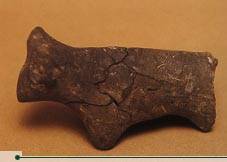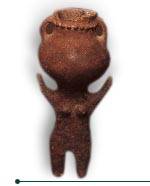 |
Keys
to the Kingdom National Anthem The Office History |
|
During the Paleolithic period (c. 500,000-17,000 BCE), the inhabitants of Jordan hunted wild animals and foraged for wild plants, probably following the movement of animals seeking pasture and living near sources of water. The climate during this period was considerably wetter than today, and therefore large areas of modern-day desert were open plains ideal for a hunting and gathering subsistence strategy. Evidence has also been found of Paleolithic inhabitation near a large expanse of water at Azraq. Paleolithic man in Jordan left no evidence of architecture, and no human skeleton from this period has yet been found. However, archaeologists have uncovered tools from this period such as flint and basalt hand-axes, knives and scraping implements. Ancient man also left clues to the nature of his existence beginning in Paleolithic times and continuing through the Neolithic and Chalcolithic eras. |
During the Neolithic period (c. 8500-4500 BCE), or New Stone Age, three great shifts took place in the land now known as Jordan. First, people settled down to community life in small villages. This corresponded to the introduction of new food sources-such as cereal agriculture, domesticated peas and lentils, and the newly-widespread practice of goat herding- into the diet of Neolithic man. The combination of settled life and "food security" prompted a rise in population which reached into the tens of thousands. |
 Animal figurine from Ain Ghazal, Pre-Pottery Neolithic period. © Ministry of Tourism & Antiquities |
| The
second basic shift in settlement patterns was prompted by the changing weather of the
eastern desert. The area grew warmer and drier, gradually becoming virtually uninhabitable
throughout much of the year. The distinction between the desert to the east and the "sown" areas to the west dates back to this watershed climatic change, which is
believed to have occurred from around 6500-5500 BCE. The most significant development of the late Neolithic period, from about 5500-4500 BCE, was the making of pottery. Earlier attempts to fashion pottery from plaster have been discovered, but it was during the late Neolithic period that man began to systematically create vessels from clay. It is likely that pottery-making was introduced to the area from craftsmen arriving from the seminal civilizations developing to the northeast, in Mesopotamia. The largest Neolithic site in Jordan is at Ein Ghazal in Amman. It consists of a large number of buildings, which were divided into three distinct districts. The houses were rectangular with several rooms, and some of them had plastered floors. The stone tower and walls found at Jericho show that defense was a consideration for Neolithic villages, as well. It seems as though Neolithic man practiced ancestor veneration, as archaeologists have unearthed skulls covered with plaster and with bitumen in the eye sockets at sites throughout Jordan (Ein Ghazal and Beidha), Palestine and Syria. Recently, archaeologists finished restoring what may be one of the world's oldest statues. The relic, which was found at Ein Ghazal, is thought to be 8000 years old. The statue is just over one meter high and is of a woman with huge eyes, skinny arms, knobby knees and carefully depicted toes. |
During the Chalcolithic period (c. 4500-3200 BCE), copper was smelted for the first time. It was put to use in making axes, arrowheads and hooks, although flint tools also continued to be used for a long time. Chalcolithic man relied less on hunting than in Neolithic times, instead focusing more on sheep and goat-breeding and the cultivation of wheat, barley, dates, olives and lentils. In the desert areas the lifestyle was probably very similar to that of modern Bedouins. |
 Female figurine with amphora on head, Chalcolithic period. © Ministry of Tourism & Antiquities |
Tuleitat Ghassul was a large Chalcolithic village in the Jordan Valley. Houses there were built of sun-dried mud bricks with roofs made of wood, reeds and mud. Some dwellings were based on stone foundations and many were planned around large courtyards. The inhabitants of Tuleitat Ghassul used the walls of their houses for artistic or ceremonial purposes, painting bright images of masked men, stars and geometric motifs, perhaps connected with religious beliefs. |